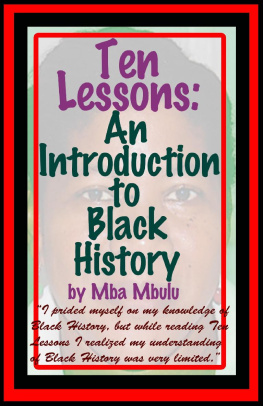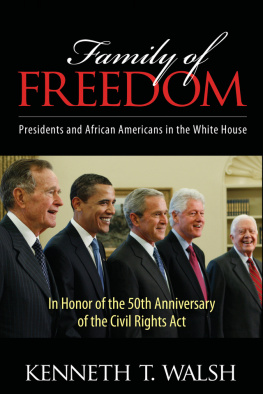Surrogate Suburbs
This book was published with the assistance of the Anniversary Fund of the University of North Carolina Press.
2017 The University of North Carolina Press
All rights reserved
Designed by Rich Hendel
Set in Utopia, TheSerif, and Serifa types
by Tseng Information Systems, Inc.
Manufactured in the United States of America
The University of North Carolina Press has been a member of the Green Press Initiative since 2003.
Cover illustration: Glenvilles Kempton Avenue in 1956.
(Courtesy of the Cleveland Press Collection, Cleveland State University Library)
Library of Congress Cataloging-in-Publication Data
Names: Michney, Todd M., author.
Title: Surrogate suburbs : black upward mobility and neighborhood change in Cleveland, 19001980 / Todd M. Michney.
Description: Chapel Hill : The University of North Carolina Press, [2017] |
Includes bibliographical references and index.
Identifiers: LCCN 2016043313| ISBN 9781469631936 (cloth : alk. paper) | ISBN 9781469631943 (pbk : alk. paper) | ISBN 9781469631950 (ebook)
Subjects: LCSH : Middle class African AmericansHousingOhioClevelandHistory20th century. | Middle class African AmericansOhioClevelandHistory20th century. | Middle class African AmericansOhioClevelandSocial conditions20th century. | Social mobilityOhioClevelandHistory20th century. | NeighborhoodsSocial aspectsOhioClevelandHistory20th century. | African American neighborhoodsOhioClevelandHistory20th century.
Classification: LCC E 185.93.02 M 53 2017 | DDC 305.896/0730771320904dc23 LC record available at https://lccn.loc.gov/2016043313
For Dad and Nihad
Contents
1 The Roots of Upward Mobility:
Outlying Black Settlement before 1940
2 Expanding Black Settlement in the 1940s:
Glenville and Mount Pleasant
3 Zoning, Development, and Residential Access:
Lee-Miles in the 1950s and 1960s
4 Racial Residential Transition at the Periphery:
Neighborhood Contrasts
5 Mobility and Insecurity:
Dilemmas of the Black Middle Class
Maps, Tables, and Figures
MAPS
I.1. Black Homeowners in Cleveland, 1930 /
1.1. African American Households in Mount Pleasant, 1930 /
1.2. African American Households in Glenville, 1930 /
2.1. Prior Location of Families Moving onto 990010499 Blocks of Somerset and Ostend Avenues, 19401951 /
3.1. Black Households in Lee-Miles, 1950 and 1960 /
4.1. Racial Residential Transition by Block, Glenville, 19401970 /
4.2. Racial Residential Transition by Block, Mount Pleasant, 19401970 /
5.1. Prior Location of Families Moving onto 1550016499 Blocks of Talford Avenue, 19571970 /
TABLES
1.1. Occupational Structure for Employed Mount Pleasant Black Household Heads, 1930 /
1.2. Occupational Structure for Employed Glenville Black Household Heads, 1930 /
1.3. Mortgaging by Black Mount Pleasant and Glenville Homebuyers, 19141930 /
1.4. Black Households and Homeownership in Mount Pleasant and Glenville, 1930, 1934, 1940 /
2.1. Occupational Structure for Employed Somerset/Ostend Avenue Heads, 1951 /
4.1. Percent Black-Occupied Dwelling Units in Lee-Harvard Census Tracts, 19501970 /
FIGURES
Class Picture, Columbia Elementary School, 1910s /
Bathers at Woodland Hills Park Pool, 1931 /
Glenville Area Community Council Meeting, 1952 /
Beach at Gordon Park, 1947 /
Lawndale Avenue in the Lee-Seville Black Enclave, 1945 /
New Homes on Myrtle Avenue, Built by Arthur Bussey, 1959 /
Vacant Land along Lee Road, 1947 /
Mount Pleasant Community Council Program, 1958 /
Houses on Glenvilles East 107th Street, 1964 /
Abandoned Apartment Building on Glenvilles East 106th Street, 1964 /
Ad for Conversion to Multifamily Occupancy, 1950 /
Glenville Area Community Council Activist Inspecting Leaf Litter, 1959 /
Lee Road Business Strip, 1979 /
Acknowledgments
Writing about ones hometown is simultaneously a joy, a burden, and a responsibilityor so it seems to me, having spent more than a decades worth of time and energy on this project. Cleveland profoundly shaped my worldview and intellectual development before I ever aspired to professional training as a historian, in spite of my suburban upbringingfrom the childhood field trips spent accompanying my father, a Cleveland public schoolteacher in some of the East Side neighborhoods I would ultimately study, to my solo explorations of downtown as a restless teenager, to my exhilarating undergraduate days at Case Western Reserve University. Long before I ever encountered them as concepts for scholarly study, I had opportunities to ponder racial, ethnic, and religious identities: in biannual visits with family friends in Glenville, during several years spent in a racially integrated Catholic grade school in Shaker Heights, and in the Orange City School District, which includes Woodmere, a substantially African American suburb. I am grateful for all my Cleveland experiences that, over time, helped me to better understand historic demographic shifts and patterns of upward mobility in the city and metropolitan area as a whole.
Along the way I have piled up immense intellectual debts and have been humbled by the generosity and encouragement of mentors, colleagues, friends, and family. First and foremost, I would like to express my gratitude to the staff at the University of North Carolina Press, and especially to editor Brandon Proia, who believed in this project from the very beginning and offered invaluable support throughout the entire process. Thank you also to Jad Adkins for handling practical matters and to Dorothea Anderson for outstanding copy-editing, as well as to Jay Mazzocchi, Susan Garrett, and Kim Bryant for additional technical assistance. Extra special thanks to the anonymous reviewers who gave such generous and thoughtful suggestions on revisions. I also relished the opportunity, in preparing the final manuscript, to collaborate with an extraordinarily talented cartographer, Nat Case, on the accompanying maps; not only did he produce final drafts that far exceeded my expectations, but I got to hone my GIS skills in the process.
I am very fortunate to have had supportive mentors who encouraged my intellectual inquiries from undergraduate through graduate study and beyond. I owe special debts to three in particular: John J. Grabowski at Case Western Reserve University and Rudolph Vecoli and David Roediger at the University of Minnesota. John first introduced me to the wonders of archival research in an undergraduate seminar and later supervised me when I worked as a manuscript processor at the Western Reserve Historical Society; he also was the first to suggest I consider pursuing a graduate degree in history. Rudy oversaw my training as I commenced graduate study in American immigration history and read numerous chapter drafts as my dissertation adviser; I particularly miss his directness and attention to detail, not to mention his twinkling gaze. Dave profoundly influenced my scholarly trajectory by expanding my knowledge of African American history and focusing my attention squarely on race, and after Rudys untimely passing in 2008, Dave graciously mentored me through my early career. I have benefited from his sound advice on numerous occasions and am constantly amazed not just by his capacious mind, but also by his example as the very paragon of a mentor and colleague. Other particularly important teachers and mentors were Catherine Kelly, Kenneth Ledford, Erika Lee, Miriam Levin, Lary May, Jeani OBrien, Richard Rudolph, and Angela Woollacott.



